Affiliate disclosure: This post may contain affiliate links. Please see our Privacy Policy.
Removing tree stumps, or getting tree stumps to rot faster than they would naturally, is actually quite simple. By learning how to make a stump rot faster, you can remove tree stumps naturally without resorting to calling in an expensive tree service.
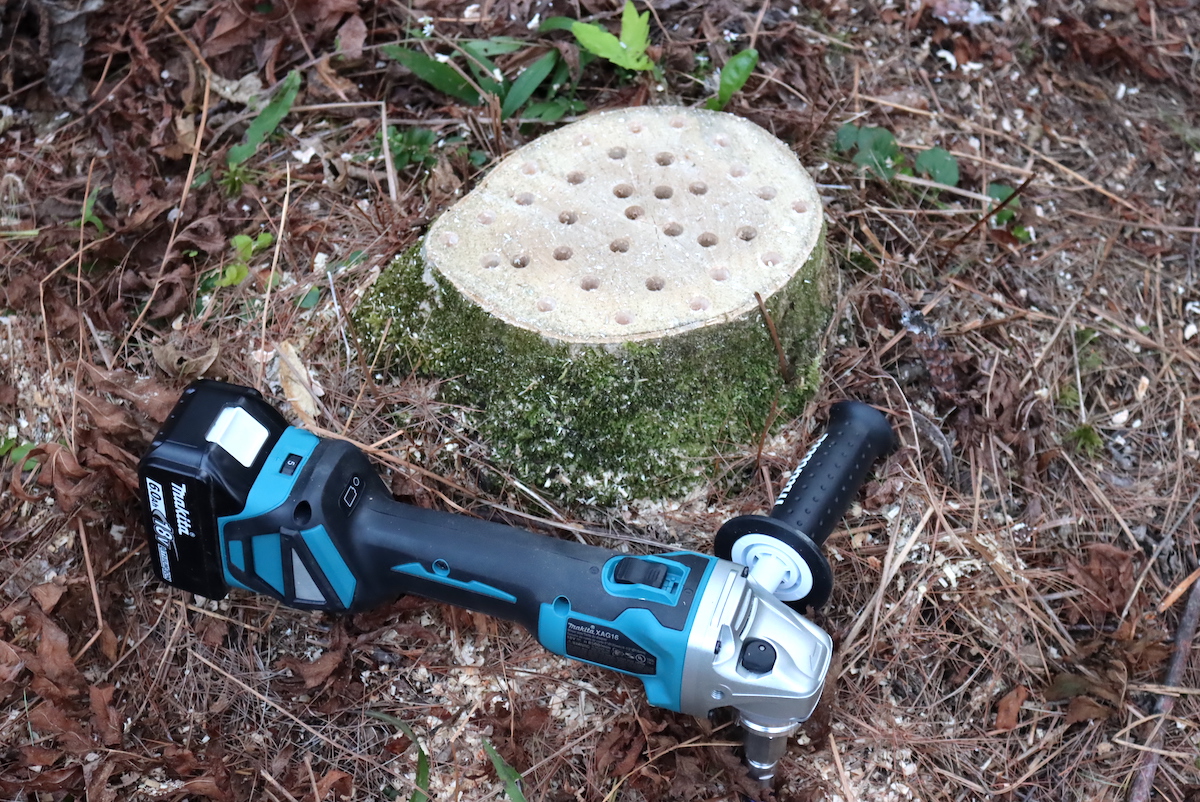
Living on a woodland homestead and cutting all our wood year after year means we have a lot of tree stumps. Now with the emerald ash borer, pine bark beetles, and all manner of other pests killing off whole tree species, we find ourselves struggling to keep up with all the standing dead wood.
This past year, we lost several acres of ash trees to borers and decided to make the best of it by turning the land into pasture.
Generally, converting woodland to pasture requires decades of patience while the stumps rot naturally or hiring a bulldozer or commercial stump grinder to clear the land faster. Both of those mechanical techniques can be incredibly damaging to land and soil, not to mention expensive.
Encouraging stumps to rot naturally in place can save you a lot of money, not to mention prevent erosion and other damage to your land in the process.
Whether you have just a single stump to rot on in your front yard, or hundreds of stumps to rot in your back forty, the process is the same.
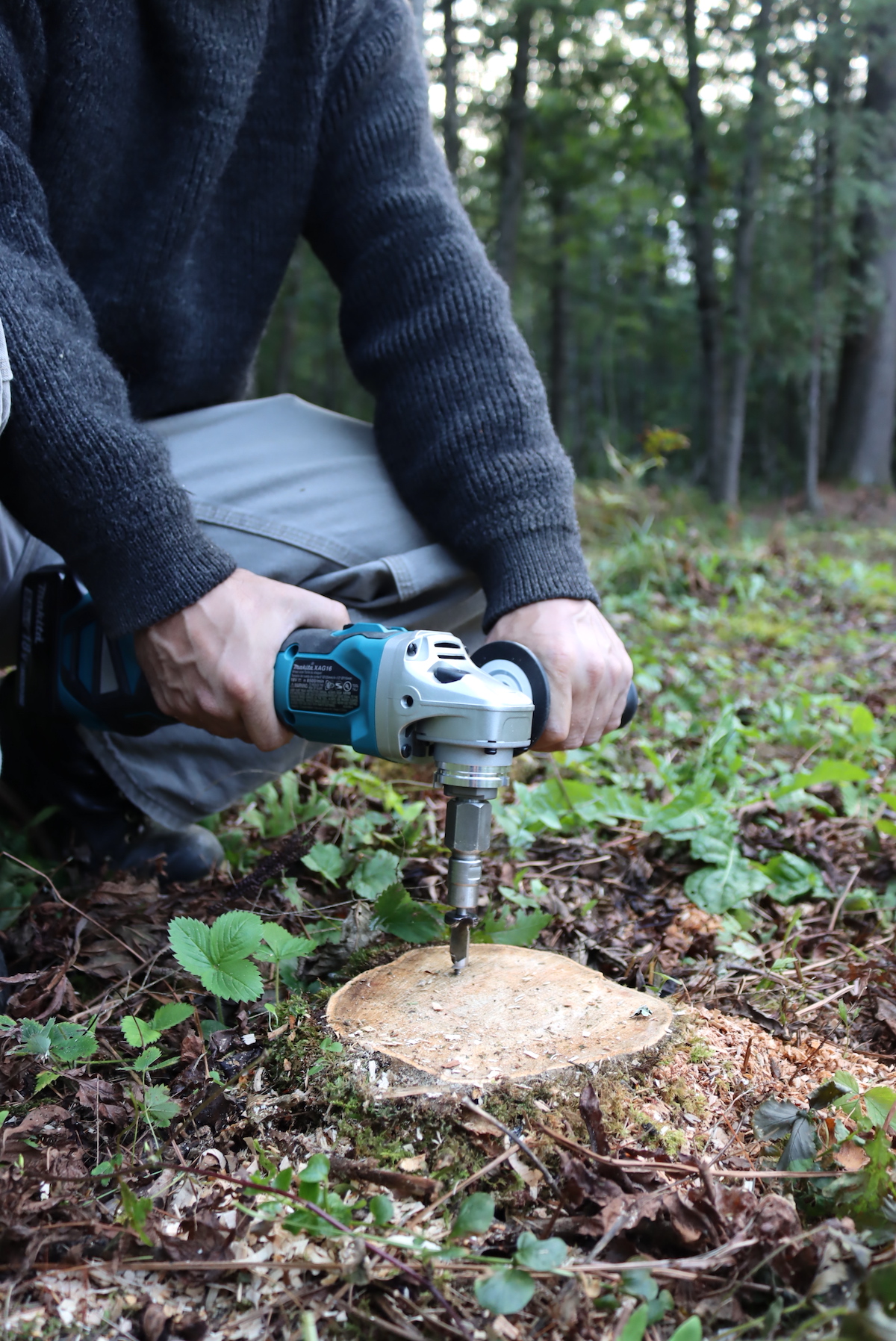
How Long Does it Take Tree Stumps to Rot?
Tree stumps will rot naturally over time, but in most cases, they take a very long time to rot away fully.
Even soft wood from pine trees can take 15 to 20 years to rot away entirely, and more rot-resistant hardwoods might still be in place 50 or more years after the tree itself is gone. How do you make stumps rot faster?
The trick is using a bit of biology and encouraging the natural biological processes that break down wood in the first place. With a bit of encouragement, you can fully rot a stump in as little as 6 weeks in ideal conditions.
Even without ideal conditions, stumps can be fully rotted in as little as 8 to 12 months with this technique (instead of decades).
How to Make a Tree Stump Rot Faster
If you want to make a stump rot faster, the main trick is increasing the surface area so it’s more exposed to the elements while at the same time feeding the bacteria and fungi that will decompose the stump. In a nutshell, that means drilling holes into the stump and then adding nutrients.
The basic steps to rot a tree stump are:
- Cut the Tree Stump Off as low as you can ~ The less material there is to rot, the faster it’ll break down. Try to flush the stump off as close to ground level as possible.
- Drill holes into the remaining stump ~ By making holes down into the tree stump, you’re encouraging water and nutrients to be trapped in the wood, which will make it rot faster.
- Add Nutrients ~ One of the reasons trees don’t rot quickly is they’re almost all carbon. To compost properly, microbes need carbon, nitrogen, and other trace nutrients.
- Mulch the Stump ~ This helps hold in moisture and encourages the stump to break down faster. Any natural mulch will work, from bark mulch to just raked leaf mulch.
Cutting The Stump Off Low to the Ground
The first step is pretty self-explanatory. Get the stump as low as you possibly can. If it’s possible to run a chainsaw (or hand saw) parallel to the ground and flush the stump off at ground level, that’s perfect. Some stumps are tricky, and they’re either oddly shaped or just too large to cut reasonably, but do the best you can.
The less wood there is to rot, the faster the stump will disappear.
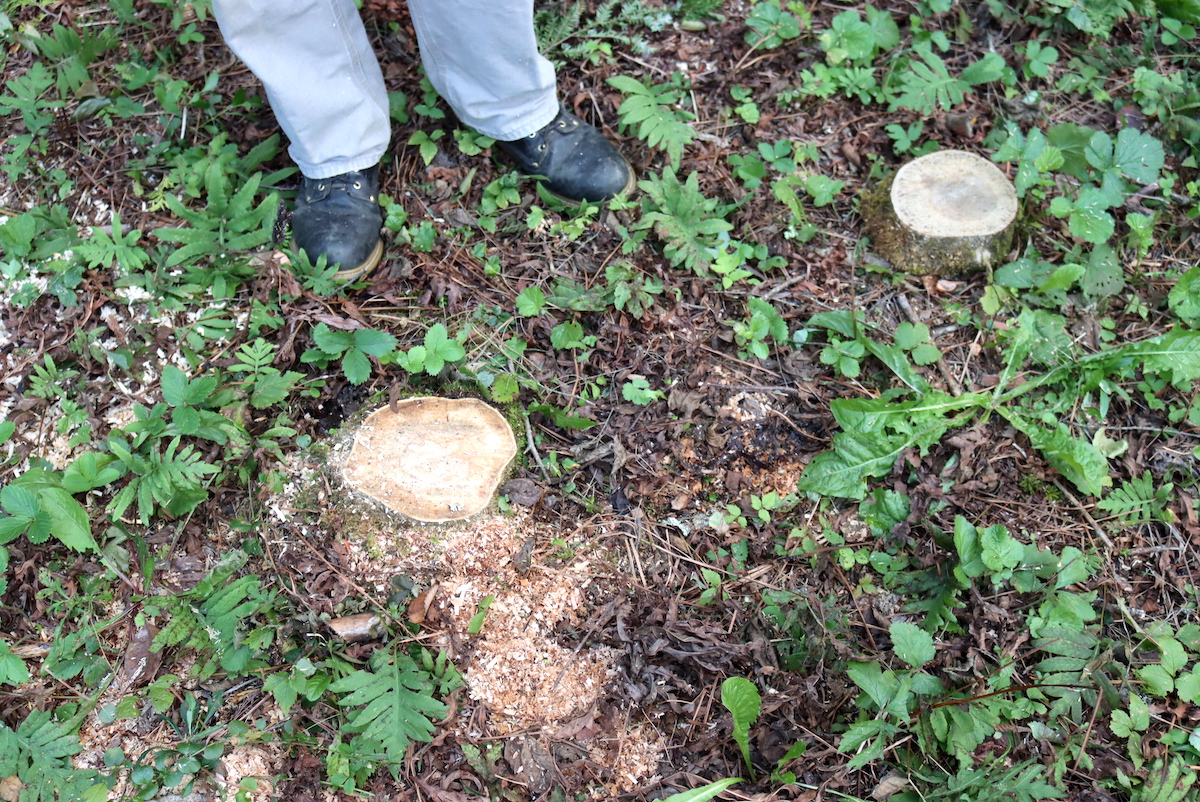
Drilling Holes in Stumps
Next, drill holes in the stump.
They should go down vertically into the stump so that they create little pockets to trap rain, moisture, and nutrients. Water rots wood quite effectively, and making sure the stump stays consistently moist is the first step.
If you just have a single stump to rot, choose the biggest drill bit in your toolbox and make as many holes as you can with a small electric drill. Ideally, you’d want holes about 1/2 inch wide and a couple of inches deep. A cordless or corded drill with a sharp bit can drill a single hole in about 3 to 5 seconds, and you want to aim for as many holes as you have the patience to make.
In our case, we’re trying to rot around 40 stumps, so we’re using something a bit more heavy-duty. It’d take hours to drill holes in that many stumps with a cordless drill, but it takes about 5 minutes with an angle grinder and drilling attachment.
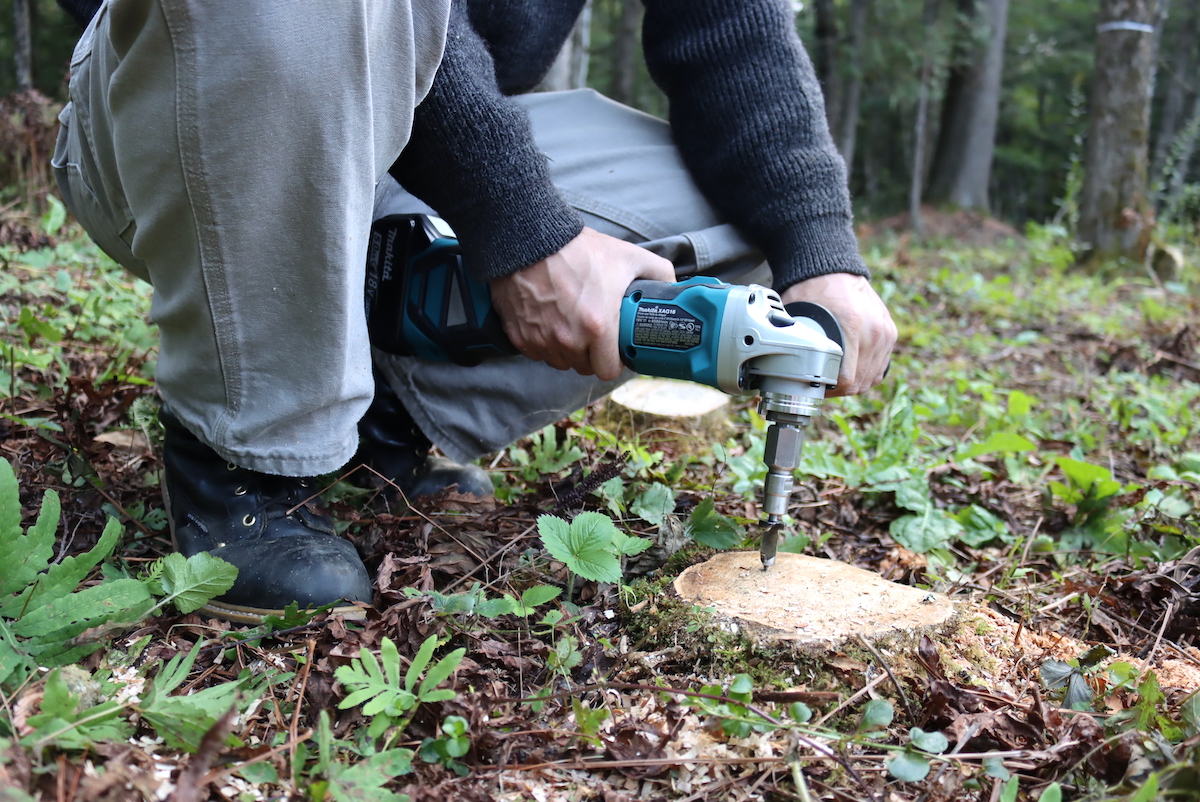
Generally, angle grinders spin at too high a speed for drilling, and you cannot use regular drill bits in them (they’ll break). Commercial mushroom farms drill a lot of holes in wood to put in mushroom spawn plugs each season, and a hand drill is way too inefficient. They’ve developed strong, sharp drill bits and an attachment that will turn an angle grinder into a hole drilling machine.
If you’re trying to rot a lot of stumps at once, I’d highly recommend investing in an angle grinder and a drilling adaptor, and if you’re ambitious, you can use it to grow shiitake mushrooms in your backyard too.
We’re using the following:
- Battery Powered Angle Grinder ~ It’s super efficient, and you can drill holes in about 40 stumps (10 to 18 inches each) on a single battery charge with the Makita model. It also has a “stay on” mode, which allows you to drill holes as fast as you can move. (Be careful though, it will drill through you faster than a stump.)
- Angle Grinder Drill Attachment ~ This allows you to put a specialized drill bit into your angle grinder.
- Drill Bits for Angle Grinder ~ These are specifically designed to drill quickly into the wood and take the high torque of an angle grinder. Do not attempt to use regular drill bits in an angle grinder. They come in 8.5mm and 12mm sizes. Both will work for rotting stumps, but the bigger one will be more effective.
With this setup, I can literally drill 3 to 5 holes in a second. The bit cuts through wood stumps like a hot knife through butter, and it takes no more than 5 seconds to drill a few dozen holes in a single stump. (A regular drill would take about 10 to 20 times as long, and is much harder on your wrists as you work.)
An angle grinder has dozens of other uses when you’re not drilling stumps, so it’s a handy tool to have around. The drilling setup is relatively inexpensive, so worth it even if you’re only using it for stumps. In our case, we use the same setup when we’re growing shiitake mushrooms and other mushrooms on logs, so it comes in handy often.
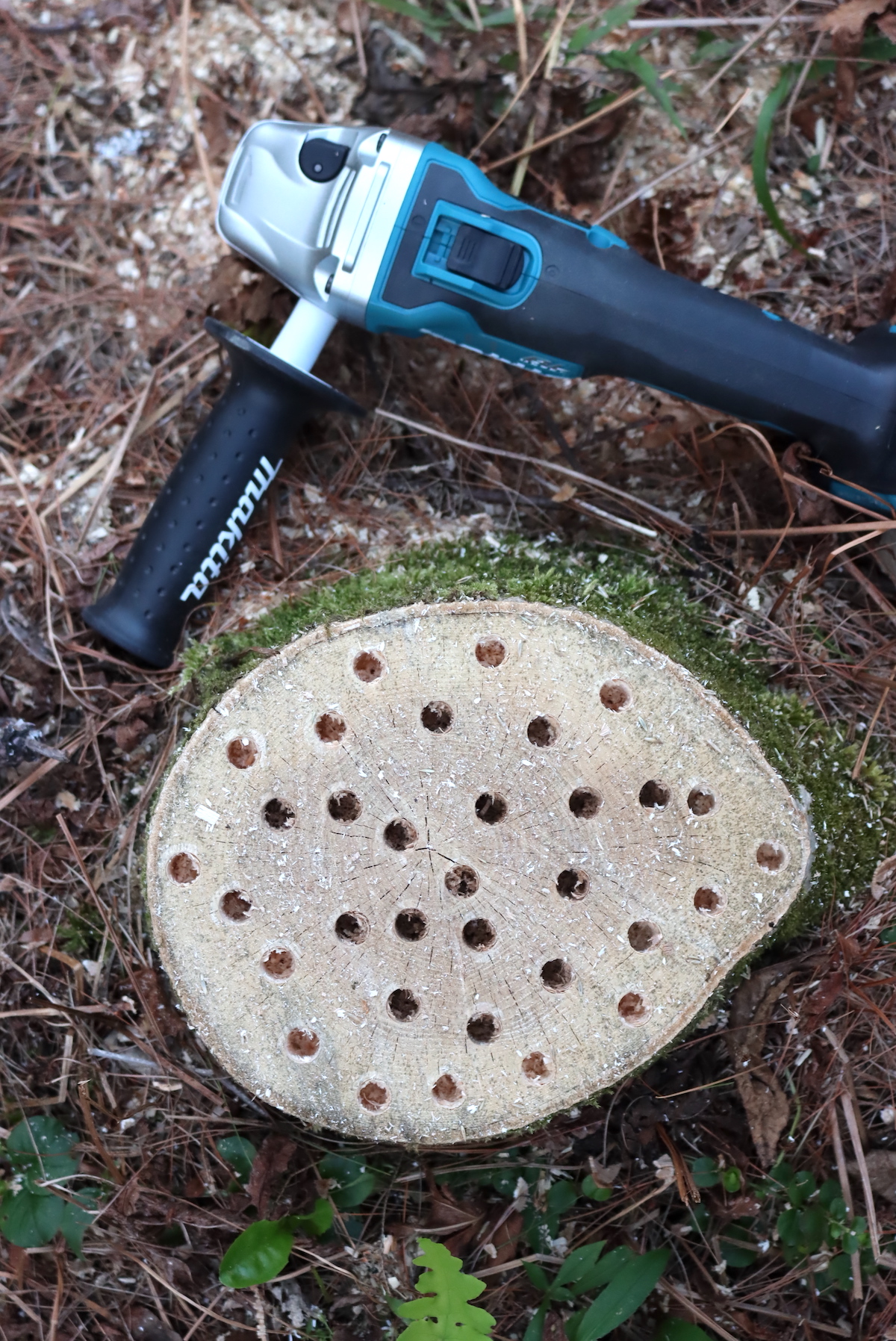
Encouraging Stumps to Rot
At this point, the holes will already encourage the stump to rot, and cut the whole time to rot in half. A stump that would have taken a decade to rot will be gone in about 5 years just because the holes trap rainwater.
If you really want to get a stump to rot, you’ll have to feed the bacteria and fungi in the soil, or more specifically, balance the nutrients in the stump to allow the bacteria to efficiently process the wood.
Wood is almost entirely carbon, and if you know anything about backyard composting, you know that it’s important to balance the ratio of carbon to nitrogen to encourage materials to break down.
The ideal ratio of carbon to nitrogen in compost is around 30 to 1. That’s 30 parts carbon for every 1 part nitrogen. Wood is naturally around 500 to 1, since it’s almost entirely carbon.
The microbes need a lot more nitrogen to break down a stump.
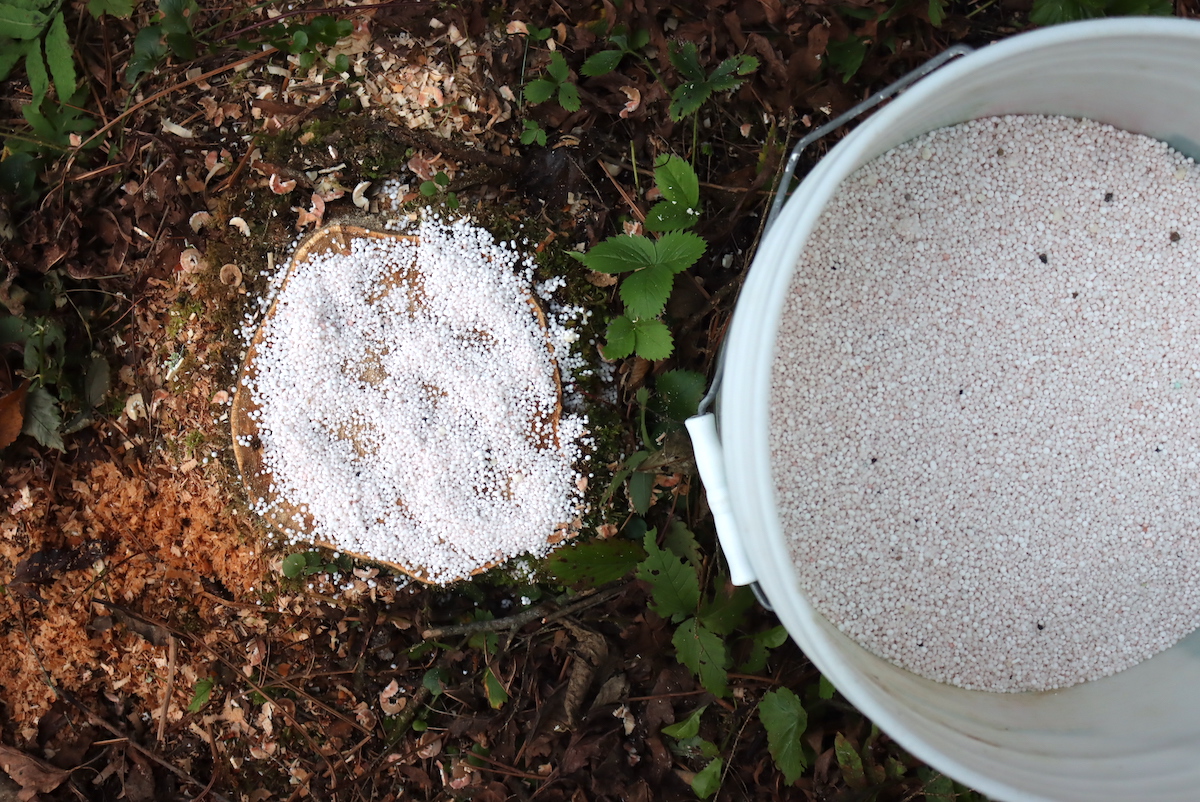
What to Put On a Stump to Make it Rot (Pet Safe Options)
There are a lot of ways to add nitrogen to a stump to encourage rot.
The most effective method is to add pure potassium nitrate pellets, which are just pelletized nitrogen fertilizers. You can buy this inexpensively online, but it’s usually not available in local stores. It’s too concentrated to be used on plants as it is, so it’s not sold that way at your local garden store.
Potassium nitrate is actually sold as “stump remover pellets,” and commercial sump remover solutions are almost entirely potassium nitrate. Spectricide stump remover, for example, is liquid potassium nitrate along with a bunch of other chemicals that help kill the tree down to the tip of the roots at the same time.
Lab-grade potassium nitrate is much less expensive if you have a lot of stumps to remove, and it’s much more natural than a prepared blend that includes other potential toxins.
Be aware that while potassium nitrate is a natural source of fertilizer, it’s not exactly something you want to bathe in or allow your pets to eat. If you have pets around, do not let them eat the powder.
If you can’t keep pets away from the stump, I’d suggest going with a bag of “yeast nutrient,” which is a food-grade nitrogen that’s used in winemaking. It’s meant to feed the yeast in a fermentation process, and it’s completely food safe. Be aware that “yeast nutrient” is not the same as nutritional yeast, and it can only be purchased online or at specialty winemaking or homebrewing stores.
Beyond that, you can use other sources of nitrogen like regular pelleted fertilizer or even a few scoops of miracle grow. Lawn and garden stores also sometimes sell bags of “compost booster,” which will also work.
Other than fertilizer, you can also use other things you have on hand, like natural buttermilk. In a pinch, urine does the job too. Yes, you can dissolve a stump by drilling holes into it and peeing on it regularly. Put your boys to work, and it’ll be gone in no time. (Make sure you drill holes though, that’s what traps the nutrients against the wood.)
Things You Can Use to Rot a Stump
So, in summary, once you’ve drilled the holes, you can use any of the following to rot the stump:
- Potassium Nitrate Pellets ~ The most effective method, but not pet safe.
- Yeast Nutrient ~ Actually just food-grade urea, so a source of food-safe nitrogen that you can use around pets/kids/etc.
- Miracle Grow (Or other high nitrogen fertilizer) ~ Works well, more available locally, but not as concentrated as potassium nitrate.
- Cultured Buttermilk ~ Natural cultured buttermilk is also a good source of nitrogen, and it contains probiotics that will help digest the stump. It’s much slower than other nitrogen sources, and you’ll need to dump a bit more buttermilk on the stump every week or two in order to encourage breakdown.
- Urine ~ Lacking other things, you can just pee on the stump regularly to add nitrogen. This is the least effective method, as urine doesn’t have nearly as much nitrogen as actual fertilizer. Still, if you only have a single stump to rot and it’s in a private spot, you can just drill holes and encourage the men in your house to go to work on it every day.
Things You Shouldn’t Use to Rot a Stump
When rotting a stump, you’re trying to encourage biological activity. DO NOT use things like bleach.
While bleach will kill the tree quickly, it also kills the microbes in the wood and sterilizes the environment. That’s exactly the opposite of what we’re going for here.
Beyond that, things like Epsom salt will encourage rot to some extent, as they do add nutrients. Epsom salt is a magnesium salt, and many microbes do require magnesium, at least in low levels. It’s not the main limiting nutrient though, and it won’t be nearly as effective as adding nitrogen.
DIY Guides
Looking for more DIY guides to get the job done on your homestead?
- How to Install a Driveway Alarm
- DIY Grow Lights for Seed Starting
- 100 Best Books for Self-Reliant Living
- DIY Apple Storage Rack
- How to Make Soap
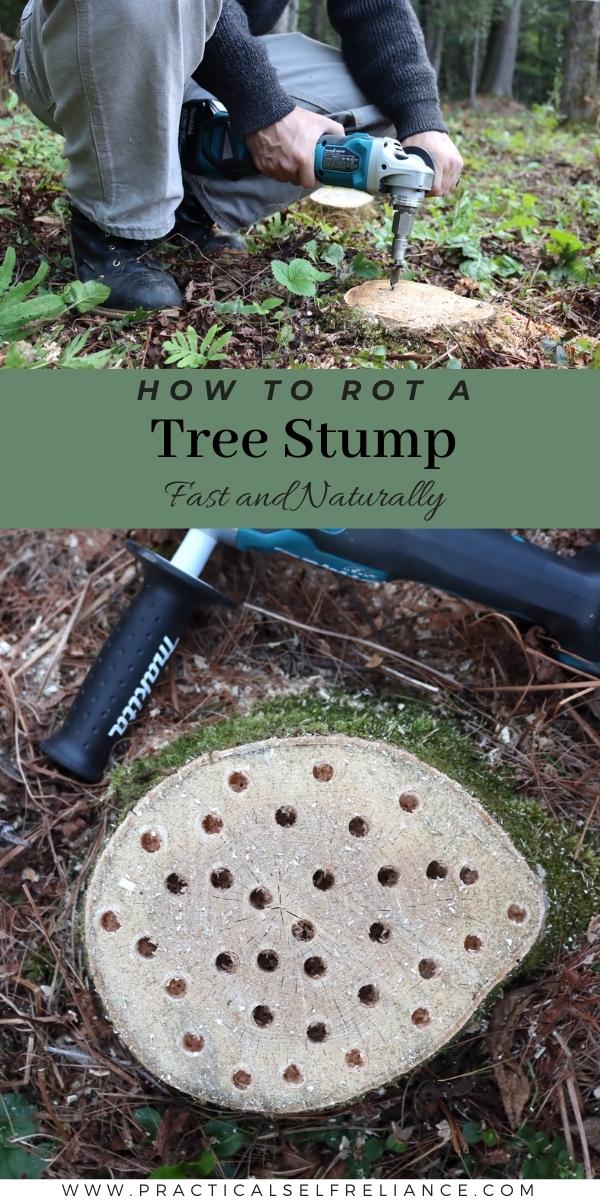
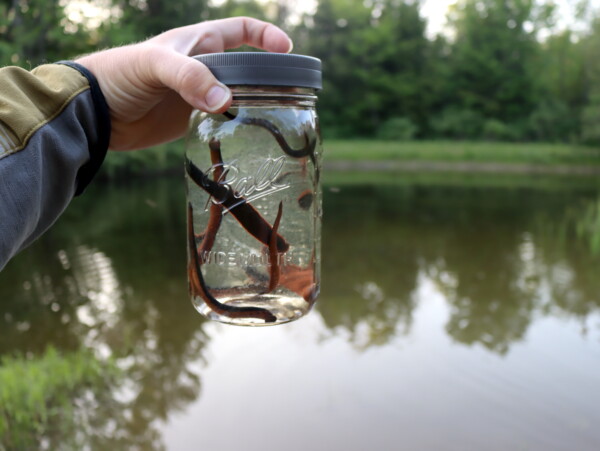
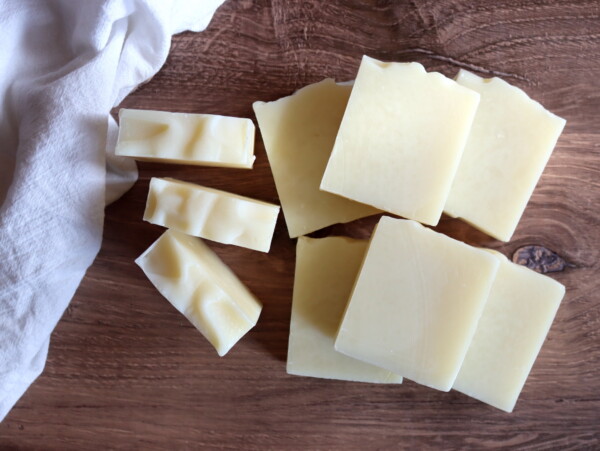
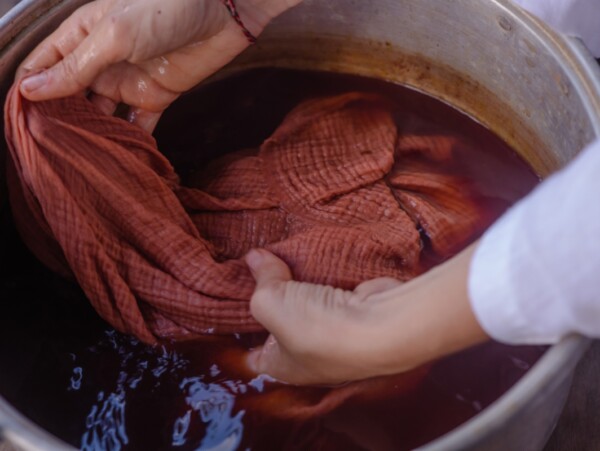
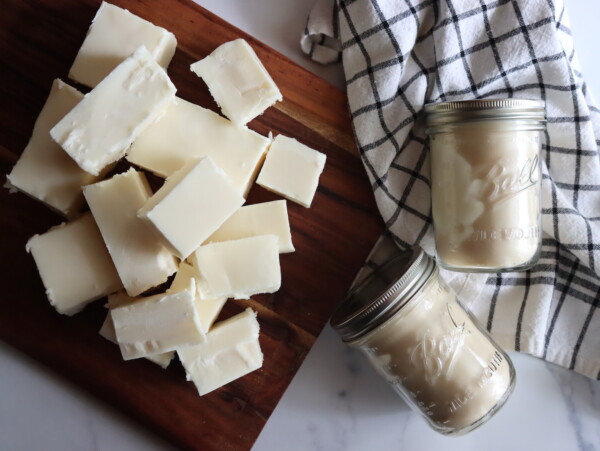










Very informative. Thanks for the knowledge.
Adamant instructions Ashley
Nice job from sleepy Vermont.
Yes, you are a dream beauty!
Useful. Thanks for putting it together.
Do you have any tips for rotting oak bark? After splitting some less than pristine wood, I’m left with a lot of bark. The maple is being used as garden mulch but the oak is too acidic.
That’s a good question, and I don’t have an answer for you. Our land is too wet to reliably grow oak, so I’ve never actually dealt with it. Google searches aren’t much help here either. Sorry I don’t have a good answer for you.
You may be making a mountain out of a mulch pile. First, decomposition tends to move pH toward neutral. Second, most plants have a wide range of acceptable pH. Finally, if you don’t have a suitable place and consider it high risk, apply some lime to offset the acid material.
Go for it, nature is full of plants growing in places you’d expect then to die. So far the strangest I’ve seen was a self seeded tomato plant, complete with a few sad to reasonable looking tomatoes, growing from accumulated bird poo on a oil platform.
I cut down a 4′ diameter liquid amber in my front yard, leaving a stump about 4′ high. For the first two years it had a 6′ stainless disc as a table top, after cutting down the trees providing it shade, the giant reflective disc had to go, before it caused a fire. The stump was exactly the same as when it was cut. I then cut it down to 2 1/2′, making the center the lowest point, I then cut out a 1′ by 1′ cube out of the middle and planted a oldhamii bamboo, that came in a 2 gallon bag, with garden soil to fill in the rest.
Nearly 4 years later, there’s 5 ~2 1/2-3″ in culms standing 12′ proud of the stump, one 4′ from the original hole I cut and a bunch of smaller culms from previous seasons. The top of the stump is a mix of rotten stump peices and bamboo litter.
A cup of lawn fertilizer at the start of summer, the lawn sprinklers reach to the top, once a week in spring/summer and rain is the only love it gets.
That bamboo has outlasted the girlfriend of the time, who said it was waste of time and would be dead in a month.
Lol. Great story. Thanks for sharing.
I had a very tall oak/shade tree in my front yard. It rotted inside and dropped big limbs. I had it cut down after it went through the car roof bc I was afraid it could hurt someone. The house is now in the HOT sun. I still have a huge stump with a black hole in the center. I was wondering if I could pant another tree in the center hole. We definitely need the shade. Right now we have a large potted cactus sitting in it.
I’m not sure how well another tree would grow in that space. I don’t think there would probably be enough room for the roots to properly grow.
I can’t think of one reason why that would be a good idea!
I guess if it worked it could provide some much needed shade but I don’t think it would work.
There is no doubt that unrotted stump and roots would restrict root growth, and rotted wood would not be a good growing medium. Trees need soil.
Decades ago I started seeing instructions to add powered milk to the holes and top, then mulch. I am surprised this was not mentioned in your article or comments to date. Have you, or do you know if others, have done a side by side experiment using different accelerants?
That sounds like an interesting technique. I have not personally done a side by side experiment. I have heard of people also using cow manure or epsom salt, watering in well, covering with plastic and then mulch.
I just searched the issue and found an article on davesgarden.com that suggested putting high N fertilizer into the holes, then over with powdered milk to encourage fungi, then water, then cover with soil (or mulch, plastic). Apparently the N will work from inside out while the fungi will work from the outside in.
Yes, I think I saw something about the high nitrogen fertilizer somewhere also.
Thanks for this timely article. We’re in the process of felling a number of invasive trees so I’d like to get rid of the stumps as well because they’re more than likely to sprout.
My question is, would mushrooms do the job? I have access to a variety of spores and I’ve always been keen to try my hand at growing mushrooms.
I’m not sure how much more quickly the stump would decompose but it would be a great use of the stump and a fun experiment.
For an aging/dying tree (with a 2 foot diameter trunk) in my backyard: after removing everything but the stump, I dug a hole under the stump. I cut the supporting roots around the stump, below ground level, and the stump dropped down into the hole and out of sight. I covered it with the dirt previously removed. Grass grew back on top and no sign of the stump ever again.
There is no way you are drilling 3-5 holes per second! You couldn’t even touch the tip of the bit down 3-5 times per second.
I’ve had great success placing a few pieces of hot charcoal from my grill on the stumps. It will smolder for hours without catching fire. I’ve burned out both green (fresh cut) and old stumps this way. Will burn below the soil line without any damage, and the ash adds nutrients back to the surrounding soil.
That’s a really great idea!
Instead of drilling holes, why not use a chainsaw to slice cuts into the stump? It would produce far more surface area than merely drilling holes. Or remove entire chunks from the stump by cutting diagonally. You would basically be creating inverted triangular pyramids of the stump wood to lift/pry out. They might even make good firewood. Lots of these pyramids could be removed from a large stump, leaving their pyramid shamed “holes” to collect water and place mulch into. Or cut the pyramids next to each other, creating one big jagged hole, then cut even deeper. with the chainsaw, or drill holes as suggested.
I followed the instructions given in this article, and after six months, the stump seems as strong as ever. I don’t want to wait years for the stump to rot itself, even when sped up a bit with added nitrogen. My own two stumps aren’t cut close to the ground–I wasn’t the one cutting down the trees.
I own a small electric chain saw, but it’s intended to remove tree branches, not cut down whole trees or perform major projects as I’ve described. Regardless, I’m giving a try with what I have available. Today, I’m cutting triangles into the stumps. Of course my little saw wasn’t designed for such things, so I have to let the chain cool off whenever it gets hot. Still, making progress slowly this way, over days or weeks, sure beats waiting years for the trees to rot themselves!
JACK. You need to be very careful that your chainsaw does not hit the ground, as it would soon get blunt or even snap. I myself will try holes and good old fire,
Did you drill holes in the top? If so then drill holes all down the sides at a diagonal drill cut then fill them up. That will help also if it isn’t real close to the ground.
Good morning!
I love your articles and have made several of your herbal balm recipes. I was reading your article on naturally getting rid of stumps. have a tree stump that I would like to use your fast-rotting suggestions on but the stump is intwined with a dogwood tree’s roots. I had to have the pine cut down but the dogwood growing immediately at its foot was saved. The arborist said the dogwood’s roots are intwined with the pine’s roots. I’m not sure if you know the answer to this but will using the biological decaying methods possibly harm my dogwood?
Thank you!
Kate
I don’t know for sure, but I honestly don’t think so. As long as the dogwood is healthy and you’re not drilling into it’s roots then I don’t think it should be a problem.
Actually rotting roots will provide organic matter benefitting any other roots in the area. The only danger is if there is something toxic in those decaying roots. All of the above treatments are nonpoisonous – they just accelerate the natural composition process. Further, I wrote my Extension Service regarding the use of triclopyr (specifically Bonide’s Stump and Vine Killer) to ask if the chemical would affect other plants in the area as dead plant’s roots decayed. They responded it does not – so only affects the live issue above ground absorbing it into its vascular system. So what accelerates decomposition has no connection with what will kill living tissue.
Those drilled holes would be perfect for mushroom plug spawn. Inoculating the fresh stumps with the proper species of mushroom should hasten decomposition and pay you back in mushrooms.
An idea just popped into my head: could stumps, cut higher, be turned into mini hugelkulture beds? They could still be drilled to hasten decomposition . Or not drilled, to keep decomposition slow.
As I type this, I picture a field filled with many domed piles of dirt. Not very attractive and probably not very practical, but still
I wonder.
Yes, definitely. And we have made some of those in the past. I even used quite a few when we did our survival gardening experiment one summer (https://practicalselfreliance.com/survival-garden/)
We have found that once buried, at least in our soil, wood doesn’t break down at all because we have such water logged soils. We’ve dug up wood after 10 years in the soil and you can wash it off and it’s still strong enough to mill into lumber, basically the same as the day it was buried. It makes our attempts at hugelculture here on our land pretty tough, since there’s not enough soil oxygen to get that stuff to release it’s nutrients (too anarobic with all the water).
That’s not going to be the case everywhere, and really that’s probably an abnormality, but that’s our experience here on our soil.
Stumps are relatively simple as you’ve outlined. I’ve always found the roots to be the real challenge when converting to pastureland. Accelerating the stump breakdown doesent carry over to the roots.